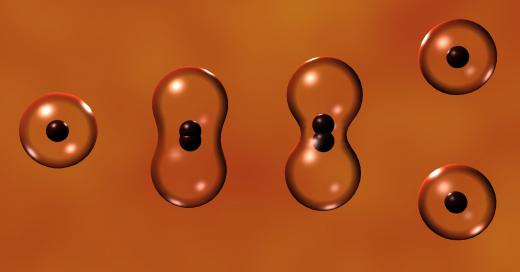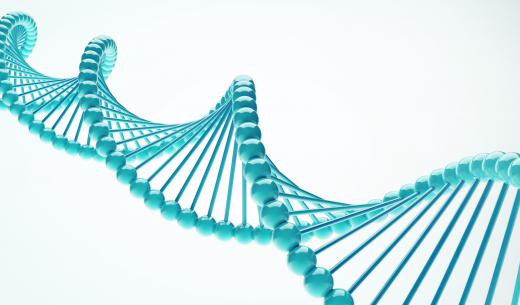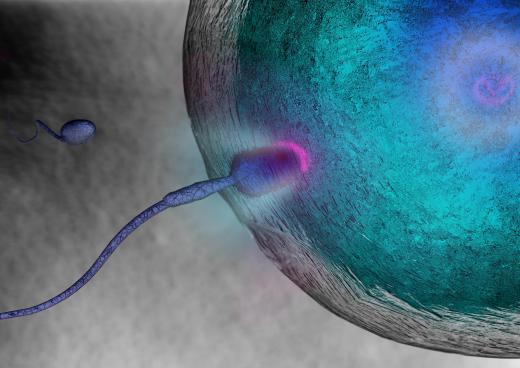What is Mitosis?
Mitosis is the process of nuclear cell division. During division, the nucleus of the cell divides, resulting in two sets of identical chromosomes, or organized DNA proteins. This process is almost always accompanied by a process called cytokinesis, in which the rest of the cell divides, leading to two completely separate cells, called daughter cells. There are four phases in the process: prophase, metaphase, anaphase and telophase. There are a number of reasons for this process, including reproduction and replacement of cells, and problems with it can seriously damage or kill cells. It's often confused with meiosis, but the processes differ in several ways.
Stages
Prophase

The DNA in the nucleus has already been duplicated in the previous stage of cell division, so by the time prophase starts, the nucleus contains two complete identical sets of DNA. As prophase begins, the chromatin, which are normally spread throughout the nucleus, begin to condense into an X shape, held together in the middle with a specific sequence of DNA called a centromere. Each half of the X is one replicated half of DNA. Once they coil together into the X, they're called mitotic chromosomes. Towards the end of prophase, the material enclosing the nucleus and the cytoskeleton disappear, except in the case of some fungi, algae, and similar organisms, in which the process happens entirely inside the nuclear membrane. This is called closed mitosis.

Once the material enclosing the nucleus dissolves, or, in the case of closed mitosis, after the DNA forms into Xs, structures called centrioles move to opposite ends of the cell and help make a spindle apparatus of microtubules, which is essentially like ropes running across the cell. The chromosomes also develop structures in the middle called kinectochores, which are later used to hook onto the microtubules.
Metaphase

As prophase finishes and metaphase begins, the rope-like microtubules connect to the kinectochores on each side of the chromosome, so that they can later pull them apart. The chromosomes align themselves with the spindle apparatus, which is spread around the cell like the vertical lines on a globe. The soon to be divided chromosomes are symmetrically positioned on the metaphase plate, which is essentially the equator of the parent cell. At the end of metaphase, each chromosome has microtubules connected to both of its halves, and they are lined up in a straight line along the equator of the cell.
Anaphase

Once the chromosomes get lined up properly, the spindle apparatus immediately pulls the two identical DNA halves apart from one another and moves them to opposite sides of the cell. These two sets of chromosomes will develop into the nuclei of two daughter cells which are perfectly identical to each other and the parent cell.
Telophase
After the chromosomes arrive at the ends of the cell, they start to uncoil and spread out again, as they were before they formed into Xs. This is basically the opposite of the beginning of prophase. While this happens, the spindle apparatus is broken down. After that, the nuclear membrane, which encases the nucleus, forms again around the chromosomes, unless it never dissolved in the first place, as in closed mitosis. Although this is the last phase, cell division is not complete until cytokinesis happens.
Cytokinesis

Cytokinesis is the next stage of cellular development, and is similar to mitosis, except it involves the other parts of the cell instead of the nucleus. During this phase, the equator-like metaphasal plate of the cell pinches together, separating the cell into two new cells. Once this is completed, there are two functioning, identical cells.
Purpose
One of the main purposes of this process is the natural growth of the parent organism. It's also done to replace cells that are worn out, damaged, or just at the end of their natural lifespan. For instance, a person continually sloughs of dead skin cells, so the body has to divide cells to make new ones. Some animals also use this process to regenerate parts of themselves, like lizards who can regrow their tails after losing them. Additionally, some animals undergo this process as part of asexual reproduction.
Problems
Problems with mitosis are devastating for cells, and can result in their death. Even if the cell doesn't die, the chromosomes can be damaged or altered, which can lead to genetic disorders; Down syndrome, for instance, is caused by a chromosomal problem that's connected to mitosis. Additionally, damage to the chromosomes or problems with the timing of how the cell divides can lead to growths and sometimes cancer. This can also happen if the chromosome isn't pulled apart properly.
Meiosis
Mitosis and meiosis are both means of cellular division, but they differ in a few key ways. First, meiosis only happens in specific types of reproductive cells called gametes — in humans, eggs and sperm — and spores. Also, in meiosis, the DNA from each contributing cell gets mixed up, with little pieces of DNA from different cells forming parts of the X. This is different from mitosis where the two halves of the Xs are identical. Also, meiosis ends up with four cells that are completely genetically unique, whereas in mitosis, the end result is two completely identical cells.
AS FEATURED ON:
AS FEATURED ON:















Discussion Comments
What does not happen in mitosis?
Our school books are so outdated compared to this.
Interphase is not a stage in mitosis.
What is a daughter cell?
What is division in plant cells?
There is only four stages as it is debatable whether interphase is actually a stage because in interphase its pretty much just a carry on from cytokinesis and the actual cellular division does not begin until anaphase.
what is the difference between mitosis and meiosis?
actually if you look at that picture of the cell cycle (the one with the arrows going around in a the circle) Interphase is one big cycle with 3 phases
1. G1
2. Chromosomes Duplication
3. G2
And lastly, it's Mitosis with four stages.
1. Prophase
2. Metaphase
3. Anaphase
4. Telophase
And after Mitosis is Cytokinesis. Cell division is not completed until Cytokinesis is finished. Then it starts back over at Interphase going through its three cycles.
So basically, everybody is wrong, besides that first comment.
There are three stages to the cell cycle: interphase, mitosis, and cytokinesis. Each stage can be further subdivided in to smaller phases. Interphase is the stage where the cell grows and but it is not actually a part of mitosis because the genetic material is actively carrying out the 'job' of the cell. The end of interphase is signaled by the visibility of the cell's DNA which indicates that the first state of mitosis has begun.
Mitosis is typically divided in to four basic phases: prophase, metaphase, anaphase, and telophase which will be discussed below since that was the focus of the original question.
Cytokinesis is the final stage of the cell's life and involves 'pinching off' the cell membrane (not to be confused with 'pinching off' the nuclear membrane during the last part of mitosis).
The key distinction between mitosis and cytokinesis is that mitosis refers to the duplication and division of the cell's nucleus and cytokinesis refers to the final division of the cell itself.
Cytokinesis is not part of mitosis because it involves the division of the cell membrane and the cell's other organelles - but not the nucleus.
Now, back to mitosis, the second stage of the cell's life cycle. The four 'major' phases of mitosis are prophase, metaphase, anaphase, and telophase. Keep in mind that mitosis refers to the duplication and division of the nucleus and only the nucleus. Each term is used to indicate the position of the chromosomes and condition of the nuclear membrane during mitosis. Prophase: chromosomes become visible and uncoil, Metaphase: chromosomes are lined up along the 'equator' of the cell by spindles from the centrosomes and the nuclear membrane begins to thin and disappear, Anaphase: the nuclear membrane is completely dissolved and the doubled chromosomes are 'pulled apart' towards opposite ends of the cell by the spindles.
Telophase: each set of chromosomes is surrounded by a new nuclear membrane and two identical nuclei now exist.
The confusion here seems to revolve around the further division of the four stages of mitosis into five or six or even more distinct phases. Prometaphase simply refers to the stage of mitosis where the nucleus is at the very end of prophase and the very beginning of metaphase.
The chromosomes don't just 'jump' from the middle of the cell to the opposite ends of the cell (although it does happen extremely fast) but it's still a progression from one position to the next. Imagine creating a flip-cartoon of mitosis – you would have to draw the chromosomes at progressively further and further points away in order to see the motion when you flipped the pages (this is a good exercise to do if you’re having trouble visualizing all of this).
Combining the four basic phases merely serves to more accurately describe the actual location of the chromosomes and the condition of the nuclear membrane at a specific time.
If you've learned the four basic phases then you've also, by default, learned the more specific phases as well. If you know what the nucleus looks like in prophase and you know what the nucleus looks like in metaphase - then prometaphase is halfway between the two.
Just to reiterate: interphase and cytokinesis are not parts of mitosis, they are distinct and completely separate parts of the cell's life cycle.
There are five phases.
there are only four and that's the correct answer.
Taking college level intro to biology now and they are teaching five phases: interphase, prophase, metaphase, anaphase and telophase.
what is the preparatory phase in mitosis?
is there a process in which it tells about the chromosomes steps anywhere?
There are four basic phases in mitosis: Prophase, Metaphase, Anaphase and Telophase. Interphase represents the non-dividing stage of a cell's life when it fulfills its specialized function.
During this time a cell is quite busy growing, synthesizing proteins, organelles and replicating DNA in preparation for the next round of cell division or mitosis. Interphase is definitely *not* part of mitosis.
Some teachers do not make this distinction very clearly. However, interphase is part of the cell's life cycle (cell cycle) so this is where people are getting confused.
there are actually five stages of mitosis: metaphase prophase anaphase and telephase.
There is 6 stages: G2 of Interphase, prophase, prometaphase, metaphase, anaphase and telophase and cytokinesis.
interphase is not considered one because of the g1 s and g2.
Actually I think that there are only four stages in mitosis. The prophase (divided into early and late prophase); the metaphase; the anaphase (divided into early and late anaphase); and the telophase.
The interphase isn't part of mitosis but actually part of the cell cycle. In the interphase the g1, s and g2 phase are included.
Doesn't matter there's four or five stages or not, I've got to study everything involved in cell division for the test!
there are actually eight: interphase, prophase, prometaphase, metaphase, anaphase, telophase, cytokinesis and then back to interphase.
There are actually 5 stages of mitosis. Interphase is part of the cell cycle, but precedes mitosis. The 5 stages are: 1. Prophase 2. Prometaphase 3. Metaphase 4. Anaphase 5. Telophase Cytokinesis is also part of the cell cycle, but this is not part of mitosis. This is part of the interphase.
yes there are five stages: the interphase, metaphase, anaphase, telophase and phrophase. i even know that and i'm very young and still in middle school.
7 stages to be more precise.
1. Interphase(Assumed to be resting but the most active and longest period of mitosis)
2. Prophase
3. Prometaphase( This stage is actually said to be in prophase but for understanding the concept of prophase better this stage is in mitosis too.)
4. Metaphase( Shortest period,)
5. Annaphase( Chromosomes are pulled apart)
6. Telephase
7. Cytokenesis( Division of cytoplasm)
Interphase has an affect, but is not actually a part of mitosis.
anon18908: there are four phases. not five.
there is actually 5 stages of mitosis: interphase metaphase prophase anaphase and telephase.
Post your comments